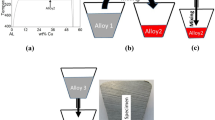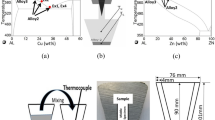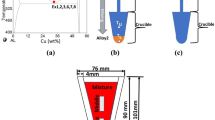Abstract
Controlled diffusion solidification (CDS) is a promising casting process. It depends on mixing two precursor alloys that have different masses and temperatures. After the mixing, anomalous grains with many morphologies form in the CDS microstructure. The formation, solidification, and stability of the anomalous grains are investigated in the present study. The high impingement velocity between the liquid stream of an alloy (Alloy1) and the alloy mixture occurs during the mixing, breaking the liquid stream to form pockets of Alloy1; these pockets move in an undercooled medium, resulting in nucleation from Alloy1 that has a higher liquidus temperature. The ANSYS software was used to provide a better understanding of the formation of the liquid pockets during the mixing step. The growth starts with a high growth rate and stable solid–liquid interface, unlike the equiaxed grains that form in the conventional casting process. A two-dimensional axisymmetric model solved by COMSOL software was built to provide a better understanding of the re-distribution of the temperature and the solute in the model to study the solidification and the stability of the anomalous morphologies. The numerical results were validated with experimental observations and scanning electron microscopy.





Similar content being viewed by others
Notes
Ansys 15, Ansys Inc.
Factsage (TM) 6.1, thermfact and gtt, technologist-1976–2009.
Comsol Multiphysics, Comsol 5.
References
A.A. Khalaf, Ph.D Thesis, Controlled Diffusion Solidification: Process Mechanism and Parameter Study, McMaster University, 2010.
A.A. Khalaf, Acta Mater. 103, 301 (2016).
D. Apelian, M. M. Makhlouf, and D. Saha, in Mater. Sci. Forum (2006), pp. 1771–1776.
M. Pourgharibshahi, H. Saghafian, M. Divandari, and G. Timelli, Metall. Mater. Trans. A 50, 326 (2019).
M. Pourgharibshahi, M. Divandari, H. Saghafian Larijani, and P. Ashtari, J. Mater. Process. Technol. 250, 203 (2017).
R. Ghiaasiaan, X. Zeng, and S. Shankar, Mater. Sci. Eng. A 594, 260 (2014).
D. Saha, S. Shankar, D. Apelian, and M.M. Makhlouf, Metall. Mater. Trans. A 35, 2174 (2004).
L. Fan, Q. Hao, and R. Shen, China Foundry Res. Dev. 12, 92 (2015).
A.A. Khalaf and S. Shankar, J. Mater. Sci. 47, 8153 (2012).
Y. Li, X. Zhang, Y. Ma, D. Apelian, H. Zhou, and X. Liu, China Foundry Res. Dev. 12, 173 (2015).
A.A. Khalaf and S. Shankar, Metall. Mater. Trans. A Phys. Metall. Mater. Sci. 42, 2456 (2011).
V. Vishan and A.V. Narlikar, Mater. Res. Bull. 11, 1257 (1976).
M. Wu and A. Ludwig, Acta Mater. 57, 5632 (2009).
W. Kurz and D.J. Fisher, Fundamentals of Solidification, 2nd ed. (Aedermannsdorf: Trans Tech Publications, 1984), p. 240.
I. Egry, M.S. Ju, and B. Hallstedt, J. Mater. Sci. 47, 8145 (2012).
S.L. Manzello and J.C. Yang, Int. J. Heat Mass Transf. 45, 3961 (2002).
C.Y. Wang and C. Beckermann, Metall. Mater. Trans. A 27, 2765 (1996).
J.J. Valencia and P.N. Quested, ASM Handbook/Thermophysical Properties (2008), pp. 468–481.
Y. Du, Y.A. Chang, B. Huang, W. Gong, Z. Jin, H. Xu, Z. Yuan, Y. Liu, Y. He, and F. Y. Xie, Mater. Sci. Eng. A 363, 140 (2003).
M. Gremaud, D.R. Allen, M. Rappaz, and J.H. Perepezko, Acta Mater. 44, 2669 (1996).
D.M. Stefanescu, Science and Engineering of Casting Solidification, 3rd ed. (New York: Springer, 2009), p. 34.
V.S. Arpaci, Conduction Heat Transfer (London: Addison-Wesley, 1984), p. 117.
G.C. Sosso, J. Chen, S.J. Cox, M. Fitzner, P. Pedevilla, A. Zen, and A. Michaelides, Chem. Rev. 116, 7078 (2016).
K. Symeonidis, Ph.D Thesis, The Controlled Diffusion Solidification Process: Fundamentals and Principles, Worcester Polytechnic Institute (WPI), 2009.
M. Qian, Acta Mater. 54, 2241 (2006).
G. Müller, J. Metois, and P. Rudolph, Crystal Growth -From Fundamentals to Technology (New York: Elsevier, 2004), pp. 34–74.
Acknowledgement
The authors are grateful to Mr. Doug Culley, Mr. Xiaogang Li, and Xiaochun Zheng for assisting with this research project.
Conflict of interest
The authors declare that they have no conflict of interest.
Author information
Authors and Affiliations
Corresponding author
Additional information
Publisher's Note
Springer Nature remains neutral with regard to jurisdictional claims in published maps and institutional affiliations.
Rights and permissions
About this article
Cite this article
Khalaf, A.A., Shankar, S. Mechanism of Anomalous Grain Formation During Controlled Diffusion Solidification. JOM 72, 3733–3743 (2020). https://doi.org/10.1007/s11837-020-04198-1
Received:
Accepted:
Published:
Issue Date:
DOI: https://doi.org/10.1007/s11837-020-04198-1




